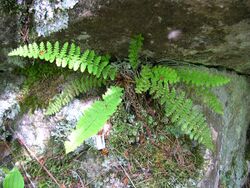Biology:Dryopteris fragrans
| Dryopteris fragrans | |
|---|---|

| |
| Fragrant fern (Dryopteris fragrans) | |
| Scientific classification | |
| Kingdom: | Plantae |
| Clade: | Tracheophytes |
| Division: | Polypodiophyta |
| Class: | Polypodiopsida |
| Order: | Polypodiales |
| Suborder: | Polypodiineae |
| Family: | Dryopteridaceae |
| Genus: | Dryopteris |
| Species: | D. fragrans
|
| Binomial name | |
| Dryopteris fragrans | |
Dryopteris fragrans, commonly known as the fragrant woodfern, a circumboreal fern,[1] is the smallest of the Dryopteris species. It can resemble Woodsia ilvensis in the wild, with which it shares the same habitat of rocky areas, shady cliffs, screes, and limestone talus.[2] It typically will not reach more than 25 cm (9.8 in) in height, and accumulates dead fronds around its base.[3]
The name refers to an appealing fruity fragrance (which some liken to primrose) that is exuded by aromatic glands found on the surface of fresh fronds. Others say that it has a spicy odor when dry. The fronds were traditionally made into a tea, as well as used as bedding by Native Americans.[4] Like many other ferns, and members of Dryopteris in particular, however, its plant material can potentially contain an antinutrient, thiaminase,[5] as well as potentially cytotoxic compounds.[6]
References
- ↑ "Dryopteris fragrans (L.) Schott" (in en). Global Biodiversity Information Facility. https://www.gbif.org/species/5275131.
- ↑ "Dryopteris fragrans". http://www.efloras.org/florataxon.aspx?flora_id=1&taxon_id=200004426.
- ↑ "Maine Natural Areas Program Rare Plant Fact Sheet for Dryopteris fragrans". Maine Department of Agriculture, Conservation & Forestry. https://www.maine.gov/dacf/mnap/features/dryfra.htm.
- ↑ Moerman, Daniel E. (1998). Native American ethnobotany. Portland, Oregon. ISBN 0-88192-453-9.
- ↑ "Dryopteris fragrans". https://pfaf.org/user/Plant.aspx?LatinName=Dryopteris+fragrans.
- ↑ Zhao, Dan-Dan; Zhao, Qin-Shi; Liu, Li; Chen, Zhong-Qin; Zeng, Wei-Min; Lei, Hong; Zhang, Yan-Long (2014). "Compounds from Dryopteris Fragrans (L.) Schott with Cytotoxic Activity" (in en). Molecules 19 (3): 3345–3355. doi:10.3390/molecules19033345. PMID 24647035.
Wikidata ☰ Q3460090 entry
 |

